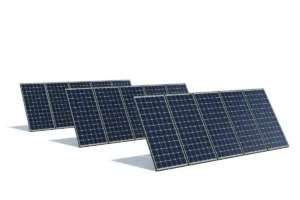Monocrystalline Solar Panels – Full Specification & Technical Details
Introduction
As the global energy landscape Moving toward sustainable and renewable sources of energy, solar light has emerged as a leading solution for meeting growing power demands. while cutting down on environmental harm. Among the various types of photovoltaic (PV) technologies availeble, monocrystalline solar panels stand out as one of the most efficient and widely used options in both residential and commercial applications. Known thise panel for their sleek appearance, impressive efficiency, and last for decades. monocrystalline panels are often considered the top choice in today’ in solar technology maket.
This article offers an in-depth information of monocrystalline solar panels, including their specifications, construction, performance metrics, along with their pros, cons and future potential in the solar industry.
1. Monocrystalline Solar Panels

Monocrystalline also called single crystal, solar panels are made from a single continuous crystal structure. They are crafted from high-purity silicon and are easily recognizable by their uniform black color and rounded edges on the individual cells. This uniformity comes from the way the silicon crystal is grown and sliced, reduce defects and allows high electron mobility—key factors for superior efficiency.
Monocrystalline panels are typically manufactured using the Czochralski process, where a silicon seed crystal is placed in molten silicon and slowly drawn out while rotating. The process produces a cylindrical ingot, which is then sliced into wafers, make those into cells, and piece them together to create a full solar panel.
2. Technical Specifications
While specifications vary between manufacturers and product lines, most monocrystalline solar panels fall within a predictable performance range. Here’s a look at typical values:
Specification Range / Value
Cell Type Monocrystalline Silicon
- Efficiency 18% – 24%
- Power Output (per panel) 320W – 700W
- Voltage @ Max Power (Vmp) 30V – 40V
- Current @ Max Power (Imp) 8A – 12A
- Open Circuit Voltage (Voc) 37V – 48V
- Short Circuit Current (Isc) 9A – 13A
- Temperature Coefficient -0.3% to -0.4% per °C
- Panel Size 1.7m x 1.0m (60-cell), 2.0m x 1.0m (72/144-cell)
- Weight 18 – 25 kg
- Frame Anodized aluminum
- Glass Tempered, anti-reflective
- Expected Lifespan 25 – 30+ years
- Warranty 25–30 years (performance), 10–15 years (product)
3. Structure and Materials
The structure of standard monocrystalline solar panel consists of the following layers:
- Front Glass :- Shields the solar cells from weather and physical damage.
- Anti-Reflective Coating: Increases light absorption.
- Monocrystalline Cells: Silicon wafers arranged in series.
- Encapsulant (EVA): Bonds and insulates the cells.
- Backsheet: Protects from moisture and UV radiation.
- Aluminum Frame: Provides structural support and allows mounting.
- Junction Box: Houses electrical connections and bypass diodes.
4. Working Principle
Monocrystalline panels work on the photovoltaic effect. Here’s a simplified process:
- Sunlight (photons) strikes the solar cells.
- Electrons in the silicon are excited and knocked loose.
- The electric field created by the p-n junction directs these electrons into a current.
- The current (DC) flows through wires and is converted to AC by an inverter for household use.
- Due to the high purity and structured nature of the silicon, monocrystalline panels offer superior electrical conductivity and lower resistance losses.
5. Efficiency and Performance
One of the most important metrics in solar panel selection is efficiency—how much sunlight is converted into usable electricity.
- Standard Efficiency Range: 18% – 24%
- Top-tier Panels: SunPower Maxeon panels exceed 22.8% efficiency.
- Low-light Performance: Monocrystalline panels perform better than polycrystalline in overcast or shaded conditions.
- Temperature Sensitivity: They lose efficiency with temperature increase, but less than some other types.
- Temperature Coefficient Example:
- A panel with -0.37%/°C loses 0.37% efficiency per degree Celsius above 25°C.
6. Advantages of Monocrystalline Panels
Advantage Description
- High Efficiency Converts more sunlight to electricity, ideal for limited space.
- Smaller Footprint Requires less roof space for the same output.
- Durability Long-lasting with a typical lifespan of 25–30+ years.
- Aesthetic Appeal Sleek black appearance, preferred for residential rooftops.
- Good in Low-Light Performs better in cloudy, shaded, or indirect sunlight conditions.
- Technology Maturity Reliable with proven long-term track record.
7. Disadvantages
Disadvantage Explanation
- High Cost More expensive to produce than polycrystalline or thin-film alternatives.
- Shading Sensitivity Affected more by partial shading unless bypass diodes are used effectively.
- Energy-Intensive Production Manufacturing process consumes more energy and materials.
8. Leading Manufacturers and Panels (2024–2025)
Brand Series Output Range Efficiency Notable Features
- SunPower Maxeon 6 AC 420W–440W Up to 22.8% Integrated microinverters, 40-yr warranty
- Jinko Solar Tiger Neo N-Type 430W–620W Up to 22.3% Bifacial, N-Type cells
- LONGi Solar Hi-MO 6 400W–600W ~21.5% Advanced cell tech, half-cut design
- REC Alpha Pure-R 410W–430W Up to 22.3% Lead-free, sustainable design
- Canadian Solar HiKu6 395W–550W ~21% High-density interconnect tech
9. Applications
Monocrystalline panels are versatile and can be used in:
- Residential Installations: Rooftop systems for homes, villas, apartments.
- Commercial Systems: Offices, malls, factories needing higher power densities.
- Utility-Scale Solar Farms: Where land is at a premium and efficiency matters.
- Off-Grid Solutions: RVs, boats, remote homes with battery storage.
- BIPV (Building Integrated PV): Panels integrated into walls, windows, roofs.
10. Installation and Mounting
Monocrystalline panels can be installed in a variety of orientations:
- Roof-Mounted (Flat or Sloped)
- Ground-Mounted
- Pole-Mounted
- Tracking Systems (Single or Dual Axis) – for increased exposure to sunlight
- Proper installation includes attention to tilt angle, orientation (south-facing in the Northern Hemisphere), and shading analysis.
11. Maintenance and Longevity
Monocrystalline solar panels require minimal maintenance, primarily cleaning dust, leaves, or bird droppings. Most panels last 25–30 years or more with gradual degradation (typically ~0.5% per year after the first year).
Regular inverter checks, wiring inspections, and monitoring software can help ensure peak performance.
12. Environmental Impact
While monocrystalline panels are environmentally friendly in operation, their production process does have a higher carbon footprint than other types due to:
- High-purity silicon processing
- Energy-intensive crystal growth
- Waste silicon from wafer slicing
However, over their lifetime, they offset dozens of tons of CO₂ emissions, making them net-positive for the environment.
13. Cost Analysis
Category Approximate Cost (2025)
- Panel Cost $0.25 – $0.40 per watt
- Total System Cost $1.00 – $1.50 per watt (installed)
- Cost for 5kW System $5,000 – $7,500 (before incentives)
- Payback Period 5 – 8 years (varies by location)
Incentives such as tax credits, net metering, and state subsidies can significantly reduce upfront costs.
14. Future Trends and Developments
Monocrystalline solar technology is evolving rapidly. Key innovations include:
- PERC (Passivated Emitter and Rear Contact) Cells
- TOPCon and HJT (Heterojunction) Technologies for greater efficiency
- Bifacial Panels that generate power from both sides
- Building-Integrated Photovoltaics (BIPV)
- Recyclable and sustainable production processes
Companies are pushing toward higher efficiencies, lower costs, and greener manufacturing.
Conclusion
Monocrystalline solar panels are a premium choice in the solar industry, offering superior efficiency, reliability, and performance. Their sleek appearance and long-term durability make them particularly attractive for residential and commercial installations. Though initially more expensive, their higher energy output and longevity often justify the investment over time.
With continual improvements in cell technology and manufacturing, monocrystalline panels are poised to remain at the forefront of the solar revolution.

